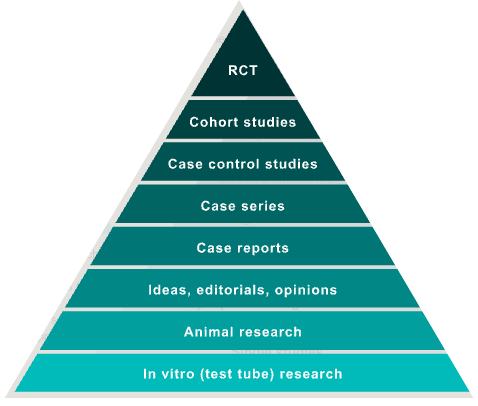Module 1.9 Hierarchies of Evidence

Different types of health and medical information are often represented within a hierarchy of evidence, with ‘single studies’ placed at the base of the pyramid and levels of analysis and synthesis of these primary research outputs represented as higher levels of evidence.
Understanding hierarchies of evidence will help lead you to the best resources, to enable you to find evidence, to help you answer your clinical question.
Consider the hierarchy of evidence below. Simple and single questions are placed at the base of the pyramid, while more problem focussed / multiple questions, are represented as higher levels of evidence, and are placed at the top of the pyramid. This Hierarchy of Evidence, is ideal to use, when you are answering a specific clinical question, versus multiple clinical questions.

Activity: Create a Hierarchy of Evidence:
Read through the Levels of Evidence Definitions and then build the Hierarchy of Evidence below by dragging the type of evidence to the correct empty box.
[Image generated using Microsoft Edge’s Copilot, powered by DALL·E from the prompt “create and image with a modern, clean design, that represents medical evidence in a pyramid hierarchy. include a doctor in the image that is looking a medical chart”.]
Now that you have created the Hierarchy of Evidence above with the different levels, click through the information icons below, to learn more about each of these types of evidence.
[Image generated using Microsoft Edge’s Copilot, powered by DALL·E from the prompt “create and image with a modern, clean design, that represents medical evidence in a pyramid hierarchy. include a doctor in the image that is looking a medical chart”.]
Hierarchy of Single Studies:
You would have come to realise that Single studies are at the base of the Pyramid, but that doesn’t mean that they are not important. Single studies have their own Hierarchy of Evidence pyramid. Single studies are considered primary research and can include randomised control trials (RCT’s), cohort studies, case controlled studies, case series / case reports and various qualitative studies, to name a few. The image below provides an overview of the Single studies hierarchy:

- Randomised Controlled Trials are the highest level of evidence within single studies, followed by;
- Cohort studies,
- Case control studies,
- Case series,
- Case reports,
- Ideas, editorials, opinions,
- Animal research,
- and the lowest level of evidence in the Single Studies pyramid is In Vitro (test tube) research.

